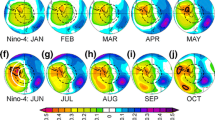Abstract
The total ozone column is well correlated with tropospheric fields such as the heights of the upper tropospheric geopotential surfaces and thus it can provide useful information on temporal variability in the troposphere. The global availability of long period satellite measurements of the total ozone column, taken by the TOMS instruments since 1978, provides a valuable and independent data set for use in studies of seasonal and interannual climate variability. In this study, the global low-frequency seasonal teleconnections in the observed TOMS data from 1979–91 have been investigated using seasonal teleconnectivity maps and empirical orthogonal function analysis. They have also been compared with the results from a simulation made with the atmospheric GCM at Météo-France, having prescribed observed sea surface temperatures for the same period. In the observed total ozone, strong ENSO-related wave number one longitudinal dipole patterns are seen in both the tropics and in the Southern Hemisphere extratropics. The model shows much weaker variability in total ozone yet appears to be able to capture similar teleconnection patterns in the tropics related to ENSO. In the SH extratropics, the model total ozone shows a strong wave number 3 response rather than the wave number one dipole seen in the observations. A wave number 3 response is also evident in the 200 hPa geopotential height simulated by the model and in the NCEP analysis, and is consistent with the response in a linearised barotropic model forced in the Indonesian region. The different responses in the modelled and observed total ozone, suggest that tropopause effect is not the major factor in the SH extratropics, and it is likely that horizontal ozone transport also plays a role in this region. Despite a generally poor simulation of the zonal mean total ozone, the model was able to capture the anomalous strengthening of the SH stationary waves during austral spring of 1988, related to an intense stratosphere sudden warming.
Similar content being viewed by others

Author information
Authors and Affiliations
Additional information
Received: 21 October 1996 / Accepted: 11 September 1997
Rights and permissions
About this article
Cite this article
Ambrizzi, T., Kayano, M. & Stephenson, D. A comparison of global tropospheric teleconnections using observed satellite and general circulation model total ozone column data for 1979–91. Climate Dynamics 14, 133–150 (1998). https://doi.org/10.1007/s003820050214
Issue Date:
DOI: https://doi.org/10.1007/s003820050214



